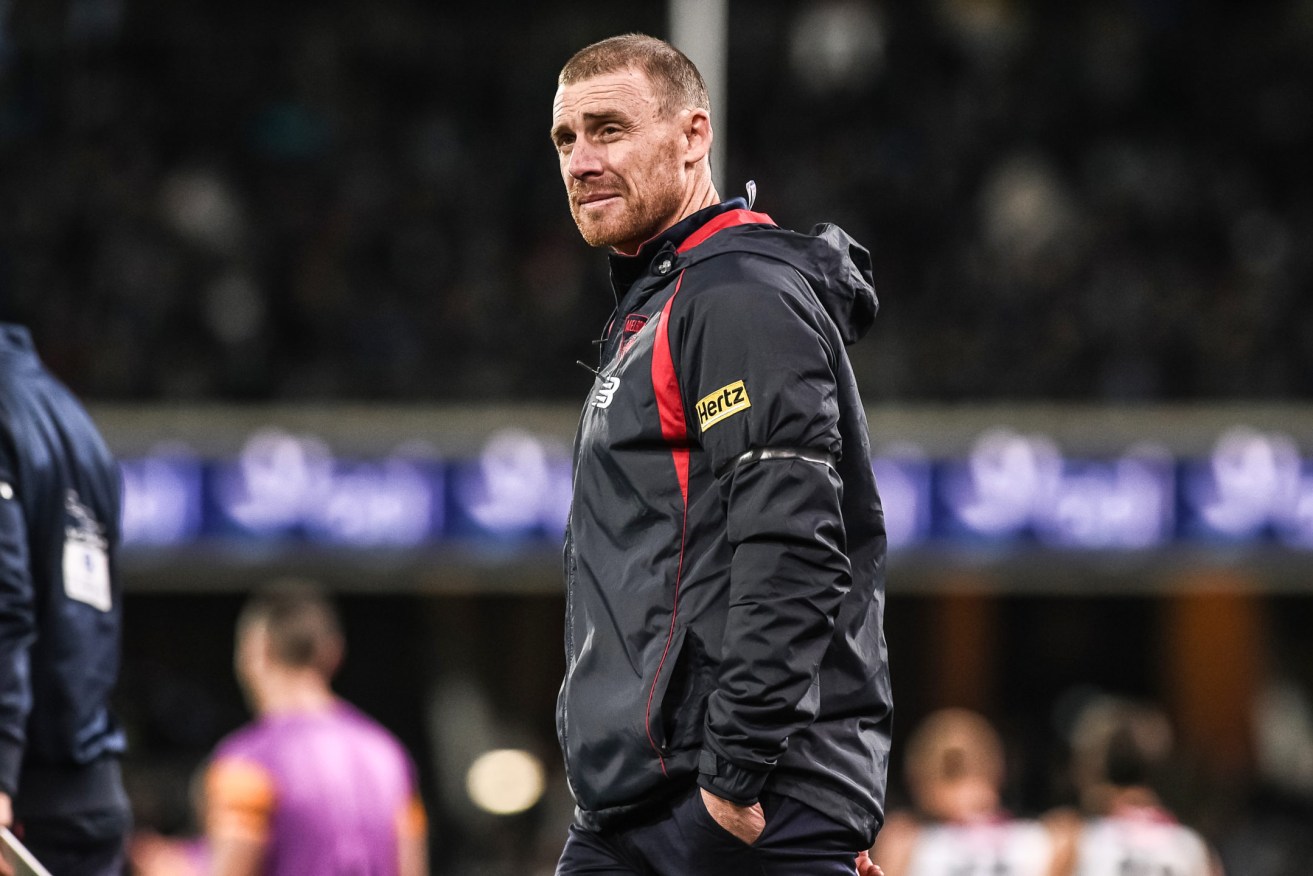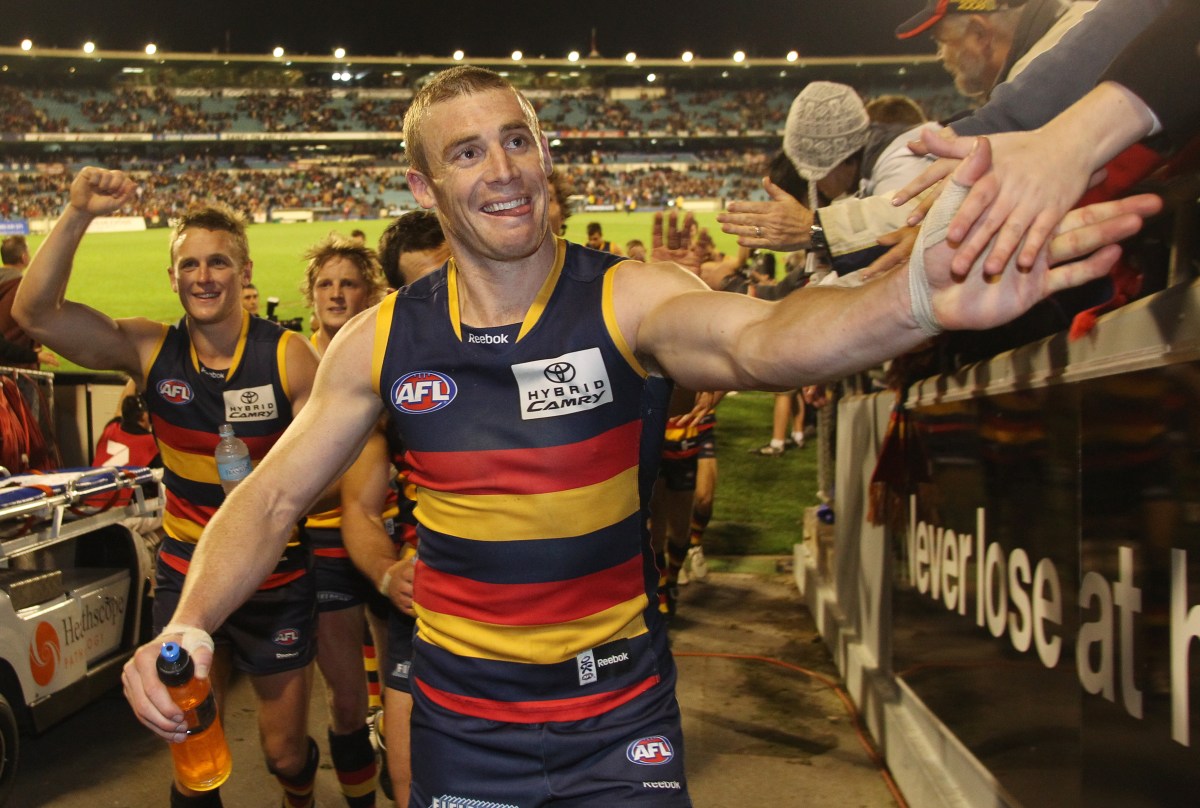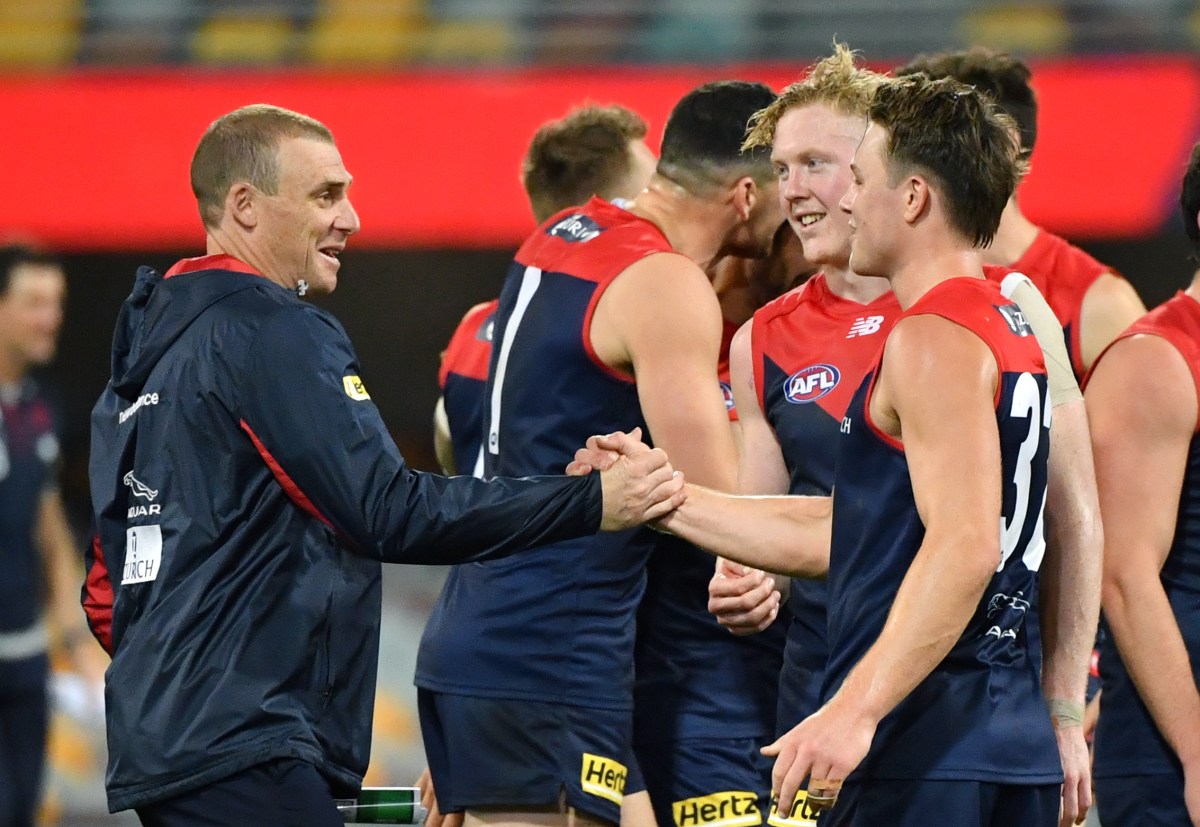Simon Goodwin and lifting the Demons’ curse
AFL club Melbourne has spent nearly sixty years searching for its next premiership coach. As former Crow Simon Goodwin takes them into tomorrow’s Grand Final, Michelangelo Rucci traces the path he has taken towards breaking the Demon hoodoo.

AFL Season 2021, Round 17, 8 July 2021, Adelaide Oval, Port Adelaide v Melbourne Demons,
Simon Goodwin this weekend could end the AFL’s longest-running premiership drought – or the 57-year curse, as some see it – and prove yet again that success in the big league demands more than a tactical genius in the coaching hot seat.
Goodwin, 44, in 2017 became Melbourne’s 13th senior coach since the sacking of Norm Smith split the club during the 1965 season. Some illustrious football names – including Brownlow Medallist Bob Skilton, Smith’s protege Ron Barassi, Neil Balme and Neale Daniher – have failed to deliver a new flag to sit alongside the six won by the legendary Smith at Melbourne.
Goodwin is leading the Demons to their third VFL-AFL grand final since the 1964 premiership triumph against Collingwood at the MCG. The Crows premiership hero was chosen in September 2014 for a two-year succession plan at Melbourne primarily for his self-sacrificing character, rather than a PowerPoint presentation on how to stop an intercept defender such as All-Australian Aliir Aliir or how to contain Brownlow Medallists Patrick Dangerfield and Nat Fyfe when they slip out of the midfield to become a goalkicking threat inside the 50-metre arc.
The moment that inspired then Melbourne chief executive Peter Jackson came from West Lakes late in the 2000s when Goodwin – described by Crows coach Neil Craig as the club’s greatest captain – mentored young gun Bernie Vince (who was later traded to Melbourne).
“It was one of those things you pick up along the way in football and store in the memory bank,” says Jackson, who was a long-serving administrator at Essendon before he answered the AFL’s call to salvage Melbourne.
“The story about Simon Goodwin relates to when Bernie Vince was coming through as a very young player at Adelaide. Simon was still one of the team leaders and a key member of the midfield.
“He thought Bernie was a player of unlimited talent, but he did not have the self-discipline (to fulfil that potential). Simon took him under his wing and he also was prepared to sacrifice himself from the midfield to play on a half-back flank, so that Bernie would get some time in the midfield.”
For Jackson this story of Goodwin “tells you about his relationships with people and his leadership skills.” To Jackson it meant far more than the alarm bells other would raise about Goodwin’s troubles in Adelaide, including the gambling saga from 2007. The AFL fined Goodwin $40,000 for betting on a league match and ordered him to enter an eight-week rehabilitation program, a moment Goodwin describes as “hitting rock bottom”.

Simon Goodwin after Adelaide’s Round 16 win over Geelong in July 2010. Photo: AAP/Ben Macmahon
“Young men make mistakes on the way through,” notes Jackson. “You have risk-taking young men in the AFL. They grow up. They learn. It is the character of Simon Goodwin that interested me.”
But Goodwin was not the first choice while Jackson plotted a revival plan, after Melbourne lost 12,000 frustrated members across two years as the Demons finished 17th of 18 in each of the 2012 and 2013 seasons when rookie coach Mark Neeld failed to revive the team.
While Sydney premiership coach Paul Roos “bought us some time and credibility” – as Jackson put it – the invitation to audition for the Melbourne coaching job was made to another South Australian. Port Adelaide and Hawthorn premiership winner Stuart Dew in October 2013 was asked to be part of a succession plan at Australia’s oldest football club (founded in 1858).
Dew had been as assistant coach at Sydney, Roos’ alma mater, since 2010 but he rebuffed Melbourne to sign a three-year extension with the Swans.
“Stuart was not ready to leave Sydney, for family reasons,” said Jackson of Dew who today is planning his fifth season as Gold Coast senior coach.
After Roos had managed just four wins from 22 games in 2013, Jackson tried again to start the succession plan at Melbourne. Goodwin was in his fourth year as an assistant coach at Essendon.
“And we had to get this succession plan right,” Jackson said. “So we asked Paul to take up the option to coach Melbourne for the third year (to allow a two-year succession plan to unfold) – and we ran the process again.”
It was more about culture – and Simon was about people.
Goodwin stood out immediately. He was delivered a five-year contract to coach Melbourne – that demanded he serve an apprenticeship with Roos – in the third week of September 2014. And while Jackson and Melbourne football chief Josh Mahoney waited for the paperwork to return with Goodwin’s signature, the heavy shadow of Adelaide football director Mark Ricciuto threatened to derail the Demons’ carefully planned succession strategy.
“At the same time Adelaide was looking for a coach (after sacking Brenton Sanderson at the end of 2014),” Jackson recalled. “So Mark Ricciuto came in, and he and Simon Goodwin are very good mates. Ricciuto saw it as a natural progression for Simon Goodwin to go home to coach Adelaide.
“So we had a lot of noise coming at us about Adelaide … and total silence from Simon.”
As Jackson and Mahoney felt increasingly uneasy while repeatedly ringing Goodwin to get no answer, Goodwin was unaware of the panic building among the powerbrokers at Melbourne. He had shut down his mobile telephone to dedicate his evening to his daughter’s speech night at a suburban school.
“And when he put his phone back on the next morning his message back to us was very clear,” Jackson recalled. “He said, ‘I told you I would take the (Melbourne) job. If I tell you I want to be with the Melbourne Football Club, that’s it. I don’t want to be with Adelaide. Stop worrying about it.’”
The contract, with Goodwin’s signature, arrived soon after at Jackson’s desk.
“We found it very interesting. He could have walked straight into a senior coaching role at Adelaide, but Simon wanted to be at Melbourne, in a succession plan,” Jackson said. “That validated what we saw as the strength of Simon’s character.”
So, after years of shooting itself in the foot, Melbourne dodged the bullet twice – first with Dew in October 2013 and then with Ricciuto nine months later – to secure Goodwin as its coach-in-waiting while Roos rebuilt the foundation of a battered football department.
Simon Goodwin has been involved in AFL football since joining the Adelaide Football Club as pick No. 18 in the 1996 pre-season draft. As part of the young guns who powered Malcolm Blight’s back-to-back premiership campaign of 1997-98, Goodwin had his first AFL premiership medal in his 10th game and second in his 31st.
“He was a very diligent young player,” says Blight of the teenager who finished with 275 AFL games at Adelaide where he won three Malcolm Blight Medals as club champion and five All-Australian honours.
“Did I see a coach-in-waiting in Simon Goodwin? No, but then I didn’t see one when I looked at myself in the mirror when I was 19 or 24. It’s funny the young players who you see as future coaches; for me it was Steve Hocking at Geelong. And then they don’t make it. Steve did it for a year and hated it. Simon is clearly one of those guys who developed his strengths for coaching as he got older.”
Goodwin hails from the South Adelaide Football Club, which like Melbourne has not won a flag since 1964. Very few in football know Goodwin as well as John Reid, another South Adelaide man who found success at the Crows as a premiership-winning administrator.
“It is a good question about when you see Simon could become an AFL coach,” Reid told InDaily. “Early days, you would not have picked it.
“We never saw him as a leader when he was a young player. But working with Malcolm Blight and Neil Craig, Simon taught himself to be a leader,” added Reid of the man who captained the Crows from 2008-2010.
“Some players just have that leadership come naturally; they are born to lead like you see with Travis Boak at Port Adelaide. With Simon, those leadership skills came from working with the right people, good people. He always had those great social skills to mix with people – and you need that to be a good leader. But bit by bit, experience after experience with good people and good programs such as Ray McLean’s leadership program, Simon became a self-taught leader … and now coach of the Melbourne Football Club.”
Blight, one of the most astute judges of today’s AFL coaches, recognises Goodwin as the classic “modern coach singing from that hymn book that preaches ‘defence first’.”
“But he is an interesting coach to observe for how he has persisted and adapted with all the ups and downs,” adds Blight of the Goodwin rollercoaster ride that has season by season has had Melbourne finish ninth (missing the top-eight finals by 0.49 per cent to West Coast) in 2017, a well-beaten preliminary finalist in 2018, 17th of 18 in 2019, ninth last year and minor premier this season.
“It is a basic coaching philosophy,” says Reid of Goodwin’s style. “Forget about talking about the game plan. Simon has worked three major themes. One, weight of numbers – you can’t have success unless you get everyone, or as many as possible, to buy into the coach’s plan. Two, personal relationships are so important. And three, care for each other,” adds Reid of a Melbourne team that is known to hug each other more than any other AFL side.
“Simon would be the first to say where Melbourne is now is about the collection of people around him, and he cares for those people.”

Photo: AAP/Darren England
And this leads back to the first meeting Jackson and Roos had with Goodwin in 2014 to measure him as a successor to the Melbourne coaching seat that had even beaten Barassi. After leading Carlton and North Melbourne to drought-breaking flags in the 1970s, Barassi returned to the Demons with a five-year plan in 1981-1985 and managed no better than eighth spot when finals were just the top-five in a 12-team pre-national VFL.
“A lot of coaching presentations,” notes Jackson, “are about gameplans and the science of the game. That’s not the key to a senior coach. He needs to build relationships with the players so that they want to play for him. He has to build the right environment so that the culture of the football department is really strong. He has to establish the right standards and behaviours.
“This was Paul Roos at Sydney where he handed those characteristics to John Longmire who has perpetuated this theme with the Swans.
“So we were looking for the same at Melbourne.
“I sat in that meeting with Paul Roos, Josh Mahoney and Todd Viney. We had no pre-determined questions. But we all knew what we were looking for.
“Simon walked into the room, he spoke of his coaching philosophies and if I shut my eyes I could have imagined I was hearing Paul Roos.
“After we compared what we had heard from other applicants, Paul and I said to each other, ‘He’s the guy’.”
Viney, who left Sturt in the SANFL to join Melbourne in 1987 and become captain in 1998, knew very early in the meeting that Goodwin he knew when coaching the Adelaide midfield had grown into a coach.
“We were at the crossroads at Melbourne. We had to work out how we were going to build our culture,” Viney said. “What were we going to stand for? Paul Roos was talking about more than Xs and Os on a gameplan or defensive set-ups. It was more about culture – and Simon was about people.
“In the first 20 minutes of that meeting with Simon I could see Roos’ eyes light up and we were all on the same page that we had the perfect succession plan.
“I had a lot of respect for how Simon had a ‘big-picture’ view of football club, not just the playing side but how things should work for numerous departments. He had the bigger vision. And I had seen how he took Bernie Vince, who was a bit of a ratbag, under his wing and made him a best-and-fairest winner at Adelaide and then at Melbourne as well.”
Goodwin started this season as a coach under extreme pressure to keep his job. After improving his home-and-away record to 57 wins, 48 losses and one draw and with a 4-1 record in finals, Goodwin on Saturday will lead Melbourne to the AFL grand final at Perth Stadium against the Western Bulldogs. He is seeking to do better than Neale Daniher managed against the imposing Essendon unit of 2000 (60-point loss) and John Northey against the Hawthorn powerhouse in 1988 (96 points).
Some say the job is cursed as a backlash to the club that sacked – and then reinstated – the legendary Smith who left Melbourne in 1967 as a wounded man.
“The curse is a real thing,” says former Melbourne captain David Neitz, the club games record holder (306 games, 1993-2008) and all-time greatest goalkicker (631).
“It’s weird but real that as a club we haven’t been able to get stability right across the board since Norm’s departure.”
Goodwin has overcome significant bad omens to get to this point. Like Smith – who was not as tactically savvy as his less-successful brother Len – Goodwin has brought together a Melbourne team built on varied personalities and backgrounds.
Like Smith, Goodwin has earned respect at Melbourne by his care of his players and his people at a long-suffering or cursed club.
“Simon has been outstanding from Day One,” says Viney. “He is always the first to pass off the credit to others, but having been there I know first hand how much work Simon does and how good he is in that coaching space.”




